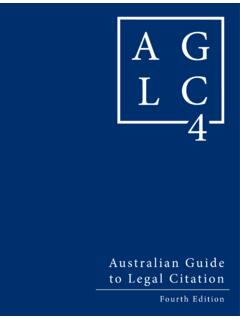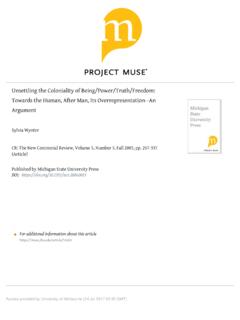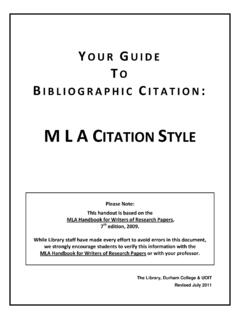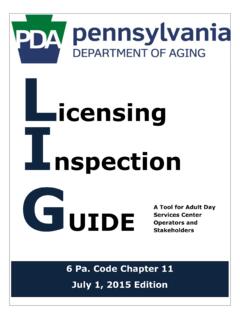Transcription of Australian Guide to Legal Citation - Melbourne Law School
1 Australian Guide to Legal CitationFourth Edition4 Melbourne University Law Review Association Inc in collaboration with Melbourne Journal of International Law Inc Melbourne 2018 Australian Guide TO Legal Citation Fourth Edition Published and distributed by the Melbourne University Law Review Association Inc in collaboration with the Melbourne Journal of International Law Inc National Library of Australia Cataloguing-in-Publication entry Australian Guide to Legal Citation / Melbourne University Law Review Association Inc., Melbourne Journal of International Law Inc. 4th ed. ISBN 9780646976389.
2 Bibliography. Includes index. Citation of Legal authorities - Australia - Handbooks, manuals, etc. First edition 1998 Second edition 2002 Third edition 2010, 2011 (with minor corrections), 2012 (with minor corrections) Fourth edition 2018, 2019 (with minor corrections) Published by: Melbourne University Law Review Association Inc Reg No A0017345F ABN 21 447 204 764 Melbourne University Law Review Telephone: (+61 3) 8344 6593 Melbourne Law School Facsimile: (+61 3) 9347 8087 The University of Melbourne Email: Victoria 3010 Australia Website: < > Melbourne Journal of International Law Inc Reg No A0046334D ABN 86 930 725 641 Melbourne Journal of International Law Telephone.
3 (+61 3) 8344 7913 Melbourne Law School Facsimile: (+61 3) 8344 9774 The University of Melbourne Email: Victoria 3010 Australia Website: < > 2018 Melbourne University Law Review Association Inc and Melbourne Journal of International Law Inc. This work is protected by the laws of copyright. Except for any uses permitted under the Copyright Act 1968 (Cth) or equivalent overseas legislation, no part of this work may be reproduced, in any manner or in any medium, without the written permission of the publisher. All rights reserved. Melbourne University Law Review Association Inc Melbourne Journal of International Law Inc 2018 Australian Guide TO Legal Citation Fourth Edition MELBOURNEUNIVERSITYLAWREVIEW v Foreword to the Fourth Edition Citation of sources has long been a defining feature of academic scholarship.
4 Even the most original thinker will have derived inspiration from the writings of others, and it is only proper that that debt be acknowledged. Citation also contributes to the history of ideas, by marking out the pathways of intellectual development. Citation of sources in judgments is, by comparison, a relatively recent phenomenon. In the High Court, for example, the number of citations per case increased tenfold between 1920 and 1996, from 23 to In part, of course, this increase reflects the growth in the length of judgments. But it is also to be explained by the evolution of paper-based argument, the much greater accessibility of judgments and academic articles, and the availability of sophisticated search Proper Citation serves important rule of law purposes.
5 Reference to authorities which govern, or Guide , decision-making ensures that the judicial process is injected with a certain degree of consistency, predictability and coherence .3 Citation makes a judge s reasons more comprehensible, and the process of adjudication more transparent, by exposing not only the path of reasoning but its foundations. Citation also enhances the development of Legal principle. Footnotes are a rich resource for practitioners confronted with the same or a related question, and for academics seeking to elucidate the principles which inform judicial decisions and to identify and explain doctrinal developments.
6 All of which makes the Australian Guide to Legal Citation ( Guide ) an indispensable resource. The Guide has given us a national language of Citation , which enhances communication across the Legal system. And it epitomises the commitment to precision and consistency on which accurate Citation depends. The Honourable Justice Chris Maxwell AC President of the Court of Appeal, Supreme Court of Victoria November 2017 _____ 1 Russell Smyth, Citations by Court in Tony Blackshield, Michael Coper and George Williams (eds), The Oxford Companion to the High Court of Australia (Oxford University Press, 2001) 98, 98.
7 2 Dietrich Fausten, Ingrid Nielsen and Russell Smyth, A Century of Citation Practice on the Supreme Court of Victoria (2007) 31(3) Melbourne University Law Review 733, 801. 3 Russell Smyth, What Do Judges Cite? An Empirical Study of the Authority of Authority in the Supreme Court of Victoria (1999) 25(1) Monash University Law Review 29, 32. vi Foreword to the Third Edition The third edition of the Australian Guide to Legal Citation ( Guide ) deserves celebration. The Guide is the successor to the Melbourne University Law Review Style Guide , the bane and vade mecum of student editors for many years.
8 The first edition of the Guide appeared in 1998 and the second in 2002. This third edition is considerably longer and more detailed than its predecessors, offering guidance on the Citation of new sources of law. Until I worked on the Melbourne University Law Review as a student in the 1970s, I was oblivious to the delights, agonies and obsessions of editorial style and Citation methods. That experience imparted enduring respect for well-tempered punctuation as well as accurate and judicious footnoting. It is easy to dismiss rules of punctuation and Legal Citation as the province of pedants and to imply that attention to such matters privileges style over substance.
9 Punctuation, however, can be critical to meaning and clarity. Lynne Truss acknowledges this significance in her charming meditation on punctuation, Eats, Shoots and Leaves, which she dedicates: To the memory of the striking Bolshevik printers of St Petersburg who, in 1905, demanded to be paid the same rate for punctuation marks as for letters, and thereby directly precipitated the first Russian As for Citation , scholars have a responsibility to acknowledge the sources of their information and ideas carefully so that they can be readily traced by their readers. In this sense, Citation practices are akin to musical scales technical exercises that ground scholarly sonatas.
10 The third edition expands and updates earlier versions of the Guide . Now Legal scholars have a stern but reliable Guide to the vexing issue of the use of ellipses in quotations, or the Citation of parties submissions in court cases. The distinction between em- and en-dashes is helpfully explicated. One particularly welcome change from earlier editions is the inclusion of examples for almost all rules. The third edition also contains a number of tables that present complex rules in a simple and accessible manner. _____ 1 Lynne Truss, Eats, Shoots and Leaves: The Zero Tolerance Approach to Punctuation (Profile Books, 2003) v.







